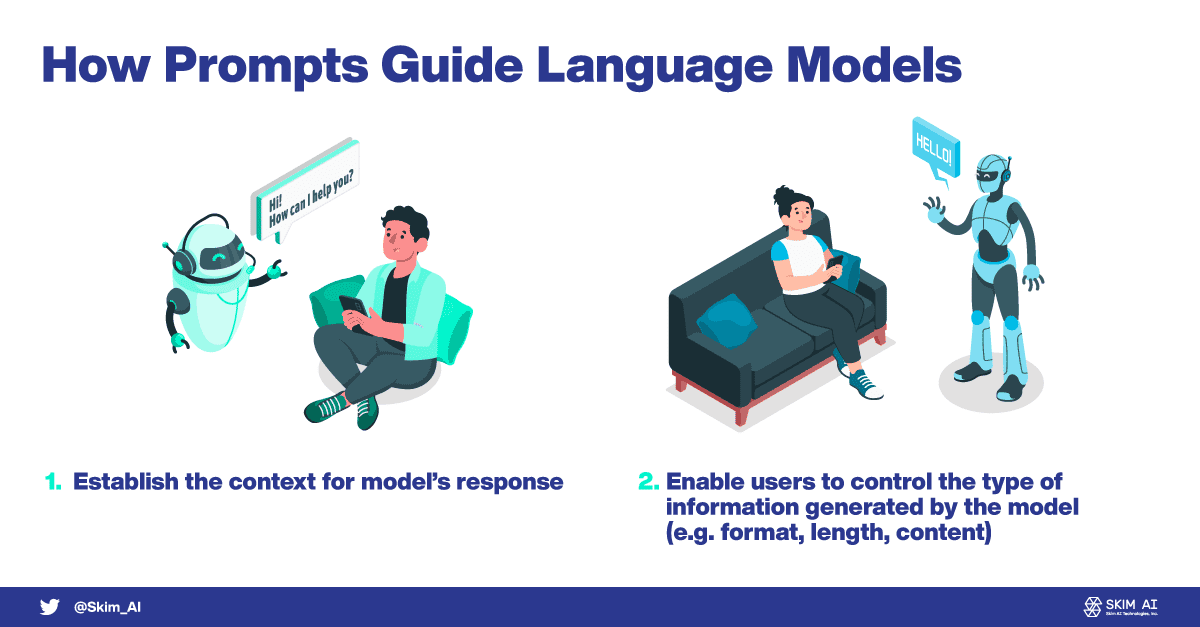Understanding the Role of Prompts in GPT and Other AI Language Models
Understanding the Role of Prompts in ChatGPT and other Language Models
Artificial intelligence (AI) language models have rapidly evolved over the past few years, revolutionizing the way we interact with technology and transforming numerous industries. One critical aspect of these models is the use of prompts, which play a vital role in generating desired outputs. In this blog post, we will explore the role of prompts in AI language models like GPT.
How Language Models Work
AI language models are trained on vast amounts of text data to understand and generate human-like language. The training process involves two main steps: pre-training, during which the model learns to predict the next word in a sentence, and fine-tuning, where the model is refined to perform specific tasks. Tokenization is another essential aspect, as it breaks text into smaller units called tokens to be processed by the model.
Several AI language models have been developed, with the GPT series (GPT-2, GPT-3, and GPT-4) being among the most popular. These models, developed by OpenAI, have demonstrated impressive capabilities in generating coherent and contextually relevant text. Other models like BERT, RoBERTa, and Transformer models have also gained prominence due to their excellent performance in various natural language processing tasks.

AI language models have a wide range of applications, including:
- Text generation: Generating articles, stories, or other forms of written content.
- Text classification: Categorizing text based on predefined categories.
- Sentiment analysis: Determining the sentiment or emotion behind a piece of text.
- Machine translation: Translating text from one language to another.
- Question-answering: Providing answers to questions based on a given context.
To see more specific applications for models like GPT, check out our blog on “10 Practical Applications of ChatGPT.”
Role of Prompts in AI Language Models
Prompts are the initial input given to a language model to guide its response. They are critical in defining the context and desired output of the model. Prompts can take various forms, such as questions, statements, or phrases, depending on the task at hand.
Prompts serve as essential guides for language models in several ways. First, they establish the context for the model’s response, ensuring that the output is relevant and aligned with the user’s intention. Second, by crafting specific prompts, users can control the type of information generated by the model, such as the format, length, or content. However, prompts also have their limitations. While they are crucial for guiding AI models, they may not always yield perfect results. AI models can sometimes generate unexpected or irrelevant outputs, which highlights the need for experimentation and iteration when working with prompts.
It’s important to note that even the same prompts can generate different responses when used with various language models or even updated versions of models from the same companies. This variation occurs because AI language models are continually evolving, with developers refining their algorithms, training data, and overall architecture to improve performance and capabilities. As a result, two different models, or even subsequent iterations of the same model, may have distinct understandings of language and context. This diversity in responses highlights the importance of adapting and experimenting with prompts to achieve the desired output when working with different language models or updated versions of existing models.

Crafting effective prompts is a vital aspect of working with language models. Clear and specific prompts lead to more accurate and relevant responses, as they provide the model with a well-defined context to generate output. On the other hand, ambiguous or open-ended prompts can encourage the model to generate creative responses, although this may sometimes result in less focused outputs. To create effective prompts, it is crucial to engage in experimentation and iteration, testing various approaches and refining the prompts based on the results obtained. This process of trial and error enables users to find the most suitable prompts for their specific needs and objectives.
To learn more about prompt engineering, make sure to check out our previous blog on “What is Prompt Engineering?”
Techniques to Improve Prompt Efficacy
Prompt engineering is a technique that involves designing and refining prompts to obtain optimal results from AI language models. This concept emphasizes the importance of understanding the model’s behavior and adjusting prompts accordingly. Here are some examples and case studies:
Iterative prompting: Breaking a complex question into smaller, simpler prompts to guide the model’s response more effectively.
Specific instructions: Including specific instructions or constraints in the prompt to shape the output, such as asking for a list of items or a step-by-step explanation.
Experimenting with different prompt styles: Varying the style of the prompt, such as using questions, statements, or conversational tones, can impact the quality and relevance of the response.
Customized training and fine-tuning can help tailor the behavior of AI language models to better align with user requirements. By training the model on a specific domain or dataset, users can improve the model’s performance in generating contextually appropriate and accurate responses. This approach is particularly useful when working with niche subjects or specialized tasks.
Customized training and fine-tuning not only enhance the AI language model’s performance but also enable companies to create a more targeted and personalized experience. With large enough datasets and sufficient budget, these companies could use such customized training and fine-tuning to create outputs that replicate their tone and style.
*Keep a lookout for our future blog on crafting effective prompts, which will provide a step-by-step proposes for top language models like GPT.
Ethical Considerations of Prompts and Language Models
As AI language models become increasingly sophisticated, it is crucial to address the ethical considerations that arise when using prompts to guide the model outputs. Ensuring responsible AI usage requires striking a balance between harnessing the power of these models and mitigating potential risks.
AI language models are trained on vast amounts of text data, which often contain biases and stereotypes present in the real world. Consequently, these models may inadvertently perpetuate these biases in their generated outputs. To address this issue, it is essential to craft prompts that encourage the AI model to generate fair, unbiased, and inclusive content. Additionally, developers should continue working on refining the training process and algorithms to reduce biases in AI language models.
For example, OpenAI relied on its 100s of millions of users and feedback points to help identify bias and undesirable outputs. But it’s important to note that newcomers in this space don’t have the same access to that amount of data.
When using prompts to guide AI language models, users should also be cautious about disclosing sensitive or personally identifiable information (PII). This is particularly important when working with shared platforms or public APIs. To protect user privacy, users should avoid using sensitive data as prompts or consider using anonymized data as input.
Harnessing the Full Potential of Prompts
Prompts play a crucial role in guiding the output of AI language models like GPT. Understanding the importance of prompts, crafting effective prompts, and employing techniques to improve prompt efficacy can significantly enhance the performance of these models. As AI language models continue to evolve and improve, it is essential for users to experiment with different prompts and learn from their interactions to harness the full potential of these powerful tools.
Crafting effective prompts is a vital aspect of working with language models. Clear and specific prompts lead to more accurate and relevant responses, as they provide the model with a well-defined context to generate output. On the other hand, ambiguous or open-ended prompts can encourage the model to generate creative responses, although this may sometimes result in less focused outputs. To create effective prompts, it is crucial to engage in experimentation and iteration, testing various approaches and refining the prompts based on the results obtained. This process of trial and error enables users to find the most suitable prompts for their specific needs and objectives.
Prompts serve as essential guides for language models in several ways. First, they establish the context for the model’s response, ensuring that the output is relevant and aligned with the user’s intention. Second, by crafting specific prompts, users can control the type of information generated by the model, such as the format, length, or content.
However, prompts also have their limitations. While they are crucial for guiding AI models, they may not always yield perfect results. Sometimes, AI models can generate unexpected or irrelevant outputs, which highlights the need for experimentation and iteration when working with prompts. For this reason, OpenAI’s beta with 100s of millions of users proved crucial in giving the company an advantage as they had access to billions of queries and feedback points. These helped the company refine the model’s output and move far ahead of competitors, something that was apparent when Google’s CEO demonstrated google’s Bard model and got an unexpected bad result, causing its stock price to drop that day






